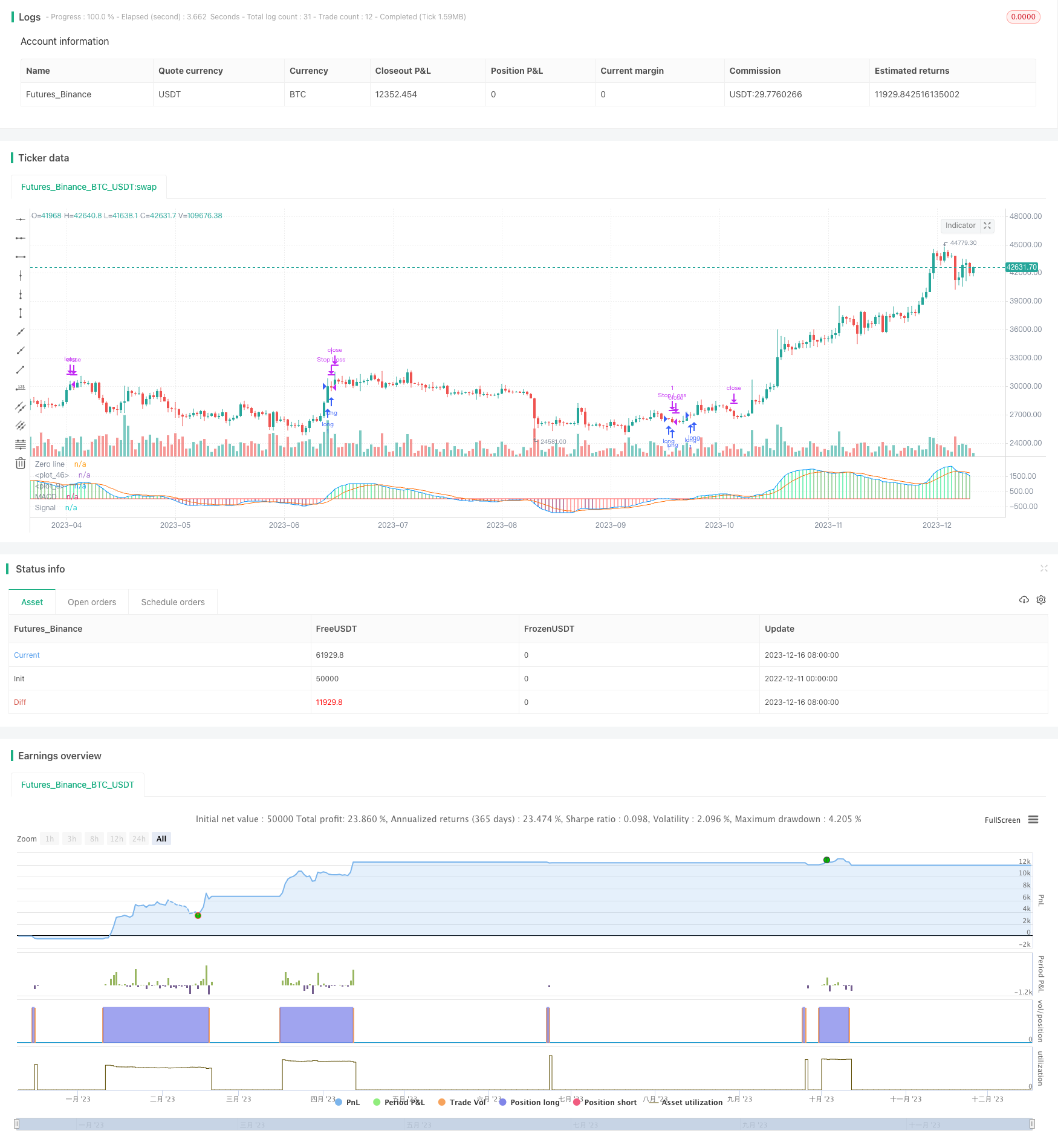
概述
本策略名为MACD机器人交易策略。该策略通过计算MACD指标的快线和慢线的关系,判断市场买卖时机,采取追踪止损来控制风险。
策略原理
该策略主要基于MACD指标开发。MACD指标是由快线和慢线组成,快线是短期平均线,慢线是长期平均线,二者关系反映市场买卖状态。当快线上穿慢线时为买入信号,下穿为卖出信号。
本策略中,快线和慢线分别采用EMA算法计算,周期可自定义。为了提高信号质量,又加入了信号线,采用EMA算法对MACD值进行再一次平滑处理。
在判定买入时机时,不仅看快慢线金叉,还要判断MACD绝对值是否大于自定义的买入线。满足则发出买入信号,采用追踪止损来控制风险。
在判定卖出时机时,要同时满足快慢线死叉和信号线为正数的条件,则发出卖出信号,平掉仓位。
优势分析
该策略具有以下几个优势:
- 使用MACD指标判断买卖时机,可靠性较高
- 增加信号线提高信号质量
- 追踪止损有效控制风险
- 买入线可自定义调整策略灵敏度
- 条件全部基于指标计算,不受外部影响
风险分析
该策略也存在一些风险:
- MACD指标存在滞后,可能错过短线操作机会
- 止损点设置不当可能造成不必要的亏损
- Parameter Tuning需要花费大量时间测试调整
- 交易成本和滑点的影响
可通过适当调整参数、组合其他指标等方式来减少这些风险。
优化方向
该策略可从以下几个方向进行优化:
- 结合其它指标过滤信号,例如KDJ、RSI等
- 增加机器学习算法判断买卖点
- 采用动态止损代替静态止损
- 对MACD参数以及买入线进行测试优化
- 考虑交易成本的影响调整策略
总结
本策略overall来说是一个可靠性较高的趋势跟踪策略。通过MACD指标判断趋势,采取追踪止损控制风险,可以获得稳定的投资回报。NEXT STEP是进一步优化参数,组合其他指标,结合机器学习等方式提高策略profitability。
策略源码
/*backtest
start: 2022-12-11 00:00:00
end: 2023-12-17 00:00:00
period: 1d
basePeriod: 1h
exchanges: [{"eid":"Futures_Binance","currency":"BTC_USDT"}]
*/
//@version=3
strategy(shorttitle = "GBPUSD MACD", title = "GBPUSD MACD")
fastMA = input(title="Fast moving average", defval = 12, minval = 7)
slowMA = input(title="Slow moving average", defval = 26, minval = 7)
lastColor = yellow
[currMacd,_,_] = macd(close[0], fastMA, slowMA, 9)
[prevMacd,_,_] = macd(close[1], fastMA, slowMA, 9)
plotColor = currMacd > 0 ? currMacd > prevMacd ? lime : green : currMacd < prevMacd ? maroon : red
plot(currMacd, style = histogram, color = plotColor, linewidth = 3)
plot(0, title = "Zero line", linewidth = 1, color = gray)
//MACD
// Getting inputs
fast_length = input(title="Fast Length", defval=12)
slow_length = input(title="Slow Length", defval=26)
src = input(title="Source", defval=close)
signal_length = input(title="Signal Smoothing", minval = 1, maxval = 50, defval =9)
sma_source = input(title="Simple MA(Oscillator)", type=bool, defval=false)
sma_signal = input(title="Simple MA(Signal Line)", type=bool, defval=false)
// Plot colors
col_grow_above = #26A69A
col_grow_below = #FFCDD2
col_fall_above = #B2DFDB
col_fall_below = #EF5350
col_macd = #0094ff
col_signal = #ff6a00
// Calculating
fast_ma = sma_source ? sma(src, fast_length) : ema(src, fast_length)
slow_ma = sma_source ? sma(src, slow_length) : ema(src, slow_length)
macd = fast_ma - slow_ma
signal = sma_signal ? sma(macd, signal_length) : ema(macd, signal_length)
hist = macd - signal
//plot(hist, title="Histogram", style=columns, color=(hist>=0 ? (hist[1] < hist ? col_grow_above : col_fall_above) : (hist[1] < hist ? col_grow_below : col_fall_below) ), transp=0 )
plot(macd, title="MACD", color=col_macd, transp=0)
plot(signal, title="Signal", color=col_signal, transp=0)
///END OF MACD
//Long and Close Long Lines
linebuy = input(title="Enter Long", type=float, defval=-0.00045)
linesell = input(title="Close Long", type=float, defval=0.0001)
//Plot Long and Close Long Lines
plot(linebuy,color=green),plot(linesell,color=red)
//Stop Loss Input
sl_inp = input(0.05, title='Stop Loss %', type=float)/100
//Order Conditions
longCond = crossover(currMacd, linebuy)
exitLong = crossover(currMacd, signal) and signal > 0
stop_level = strategy.position_avg_price * (1 - sl_inp)
//Order Entries
strategy.entry("long", strategy.long, when=longCond==true)
strategy.close("long", when=exitLong==true)
strategy.exit("Stop Loss", stop=stop_level)